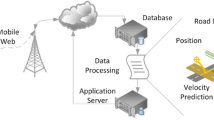Abstract
Predicting a driver’s route would be useful for warning a driver of upcoming road hazards, informing about traffic situations, and serving relevant advertising. There are many clues to a driver’s future route, including their past behavior and likely destination. Another clue is the driver’s turn choices at a sequence of intersections. Strung together, the turn choices form a route. This paper develops a basic algorithm, and variations, to predict the aggregate turn behavior of drivers at intersections. Given an intersection with a few different turn options, including the option to continue straight ahead, our goal is to infer the proportion of drivers who will take each option. For ground truth, we use raw turn counts gathered for government traffic studies by our local municipality at 40 different intersections. Our basic turn prediction algorithm is based on the assumption that drivers tend to choose roads that offer them more destination options. This matches our intuition that turning onto a short, dead-end road is relatively rare compared to turning onto a highway “on” ramp. The best performing algorithm predicts turn proportions with a median error of 0.142.











Similar content being viewed by others
References
Froehlich J, Krumm J (2008) Route prediction from trip observations, in Society of Automotive Engineers (SAE) 2008 World Congress, Detroit, MI, USA
Hu PS, Reuscher TR (2004) Summary of travel trends, 2001 National Household Travel Survey. US Department of Transportation, US Federal Highway Administration
Krumm JA (2008) A Markov model for driver turn prediction, in Society of Automotive Engineers (SAE) 2008 World Congress. Detroit, MI, USA
Krumm J, Horvitz E (2006) Predestination: inferring destinations from partial trajectories. In: UbiComp 2006: Ubiquitous Computing, Orange County, CA, USA, pp 243–260
National household travel survey daily travel quick facts. Available from: http://www.bts.gov/programs/national_household_travel_survey/daily_travel.html
Patterson DJ et al (2003) Inferring high-level behavior from low-level sensors. In: UbiComp 2003: Ubiquitous Computing, Seattle, WA, USA, pp 73–89
Redmond turning movement counts. Available from: http://www.redmond.gov/connectingredmond/resources/pdfs/redmondturningmovementcounts.pdf
Song K-T, Tai J-C (2005) Image-based turn ratio measurement at road intersection. In: IEEE International Conference on Image Processing (ICIP 2005), Genoa, Italy, pp 1077–1080
Szalay AS et al (2005) Indexing the sphere with the hierarchical triangular mesh. 2005, Microsoft Research Technical Report MSR-TR-2005-123
Weissler P (2008) Inside OnStar. In: Automotive Engineering International, July 2008, Society of Automotive Engineers, pp 34–36
Author information
Authors and Affiliations
Corresponding author
Rights and permissions
About this article
Cite this article
Krumm, J. Where will they turn: predicting turn proportions at intersections. Pers Ubiquit Comput 14, 591–599 (2010). https://doi.org/10.1007/s00779-009-0248-1
Received:
Accepted:
Published:
Issue Date:
DOI: https://doi.org/10.1007/s00779-009-0248-1




